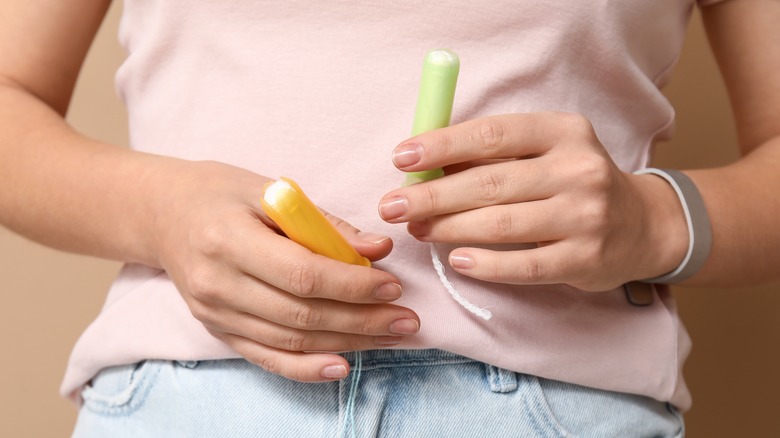Why Everyone Thinks Tampons Are Shrinking (And What That Means For Your Health)
If you first leaned the word "shrinkflation" from a TikTok about tampon sizes that went viral in April 2024, you might think it was simply a new clever hashtag. But as noted by the Michigan Journal of Economics, shrinkflation is the real-deal term for when companies downsize their products but keep prices the same in order to save money. The portmanteau of "shrinking" and "inflation" sure made a splash in the aforementioned TikTok about a theory that Tampax has supposedly shrunk their tampon sizes over the last few years. Social media users promptly took to the comments section sharing similar suspicions, with many people stating how they originally believed they were experiencing abnormal changes in menstrual flow.
@realmelissasimo Shame 👏 on 👏 you 👏 @Tampax US! #corporategreed #shrinkflation #shrinktok #groceryshopping #marketing
In the video, TikToker Melissa Simonson claimed that due to these purported changes, Tampax's absorbency ranges are no longer accurate. After the TikTok made waves, Tampax's parent company, Procter & Gamble, was quick to address the claims, emphasizing that there have been no changes in the size or absorbency ranges of their tampons for decades. "Tampons are regulated by the U.S. Food and Drug Administration (FDA) and adhere to industry absorbency or size ranges as listed on the side of each package. The FDA absorbency ranges have not changed since its introduction more than 30 years ago," a spokesperson told Glamour in June 2024. So why are so many people under the impression that tampons are now smaller than they used to be?
Potential health risks of wearing the wrong absorbency level tampon
So, why are there questions about tampon sizes? Changes in packaging may be the reason. As Glamour noted, instead of full-length cardboard applicators, some of Tampax's products now come with extendable plastic applicators, making the product appear smaller in its compact form. The company also suggests that users adjust the type of tampon they're using throughout their period to ensure it's the proper fit based on flow. For example, Tampax outlines on their website how their Super Plus tampons hold 12 to 15 grams of fluid, and their Ultra products hold between 15 and 18 grams.
Picking tampon products with the proper absorbency level is important for health. While every person's menstruation needs are different, experts generally recommend starting off with a light or regular size tampon. As pointed out by Business Insider, using too high of an absorbency size can increase one's risk for a bacterial infection known as toxic shock syndrome. According to the Cleveland Clinic, using a super-absorbent tampon during a light flow period can foster the growth of bacteria, which can then make its way into the bloodstream through tiny tears in the vaginal walls. Although toxic shock syndrome can be fatal, only 1 in every 100,000 people develop the infection. It's never a bad idea to learn how to identify signs of toxic shock syndrome.
Picking the tampon that's right for you
While you might have to experiment a little to find the right tampon absorbency level for you, experts have offered tips to make the process a little less daunting. For first-time users, Business Insider recommends a light or junior size tampon is recommended as a jumping-off point, as these products tend to be narrower. Generally speaking, menstrual flow is typically heavier at the start of one's period, so tampons with a greater absorbency level may be a better fit during those first few days. You may then want to switch to less absorbent tampons for the remainder of your period. Alternatively, regular tampons or active tampons may provide better leak protection for people who play sports or engage in regular physical activity.
As a guideline, if you're leak-free after four to six hours of wearing a tampon, it's likely the proper fit. However, if the majority of the tampon is still dry after removal, try going down one absorbency level. If you do experience leaks, consider going up one absorbency level. If super size tampons are still not effective, talk to your doctor. People with a heavier flow (also referred to as menorrhagia) may experience spotting between periods, bleeding that persists beyond a week, or find themselves needing to change their tampon much more frequently, according to Tampax. Your OB-GYN can help determine if an underlying medical condition may be responsible.



